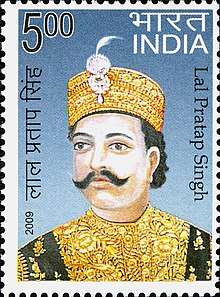Lal Pratap Singh
Rajkumar Lal Pratap Singh was a member of the Visen Rajput dynasty of Kalakankar. He was prominent in the Indian Rebellion of 1857 He was killed during the 1858 Battle of Chanda. The Government of India issued a postage stamp on 17 December 2009 to commemorate him.[1]
Lal Pratap Singh | |
|---|---|
 | |
| Born | Kalakankar, Uttar Pradesh, India |
| Died | 19 February 1858 Chanda, Sultanpur, Uttar Pradesh, India |
| Allegiance | Rajkumar of Kalakankar |
| Relations | Raja Hanumant Pratap Singh (father), Rai Bairi Sal (grand father) |
Early life
Shaheed Lal Pratap Singh born to father Raja Hanumant Singh (1826–1885) in the princely state Kalakankar of Partabgarh (now spelt Pratapgarh) near Allahabad in the Bengal Presidency of Colonial India during Company rule.[2]
Revolt of 1857
During the turbulent period of 1857 Wajid Ali Shah, ruler of Awadh, was ousted by the East India Company and exiled to Calcutta. Begum Hazrat Mahal took over the regency of the state for her twelve-year-old son, Raja Hanumant Pratap Singh (father of Lal Pratap Singh) was the Talukdar of Kalakankar.[3]
The East India Company had enforced a system of taxation called "Mahalwari", which involved constantly increasing revenue demands with consequences disastrous to the landlords and farmers.
Their increasing indebtness led to dissatisfaction and the Talukdars sided with the Begum to reinstate the Nawab and overthrow the British. Their trained armies stood ready to assist Awadh at short notice.
Pratap Jang
At the behest of the Begum, Hanumant Singh raised a battalion of 1000 soldiers under the command of his eldest son Lal Pratap Singh. This battalion, called "Pratap Jang" rose to action in February 1858 when the British under Colin Campbell, 1st Baron Clyde and Commander-in-Chief, India attempted the Capture of Lucknow.
Lord Campbell was aided by a Gurkha battalion and two Company battalions. The three forces summoned by the Begum, including the one from Kalakankar camped at chande in Sultanpur district of Uttar Pradesh awaiting the signal for battle.
On 19 February 1858, as the 'Pratap Jang' contingent sat down to breakfast, the army of East India Company attacked them. The soldiers of the 'Pratap Jang' picked up whatever weapon came to hand and pitched into the battle until ammunition ran out. Reinforcements were cut off by the Company troops and scattered remnants of other forces of the Talukdars had been forced to retreat.[4]
Killed by British
Lal Pratap Singh was advised to withdraw so that he could fight another day but the young warrior Lal Pratap led his troop into the final battle, of which the result was inevitable. many Indian soldiers and warriors died that day, among them was Lal Pratap Singh for whom a glorious death was preferable to the shame of cowardice. The humiliation inflicted on his body by the company troop commanders could not decimate the glory of great warrior Lal Pratap Singh. His untimely death devastated his father Hanumant Singh.
He left behind him a young widow princess Diggach Kunwari and a son Raja Rampal Singh Singh who born in August 1848.
Lal Pratap Singh, a loving son with a kind and generous nature, led a disciplined life, a life that has inspired his future generations to fight the good fight.
Commemoration
Postage stamp
The government of India commemorated Lal Pratap Singh by issuing a postage stamp and accompanying first day cover were designed by artist Suresh Kumar and Alka Sharma. The stamp is printed by Security Printing Press in Hyderabad.
See also
References
- "Lal Pratap Singh". indiapost.gov.in. Retrieved 15 February 2013.
- "Lal Pratap Singh". Stamp Sathi. Archived from the original on 12 April 2013. Retrieved 15 February 2013.
- "Kalakankar pricely state". members.iinet.net.au. Archived from the original on 31 October 2014. Retrieved 16 June 2013.
- "Lal Pratap Singh-Heritage of Indian stamps site". Heritage of Indian stamps site. Retrieved 15 February 2013.
Further reading
- "Dictionary of National Biography" ; SEN, S.P. (ed); Calcutta, 1972; Institute of Historical Studies ; Vol.4 p. 223
- "The Golden Book of India"; LETHBRIDGE, Roper, MacMillan & Co., 1893 p. 452–453